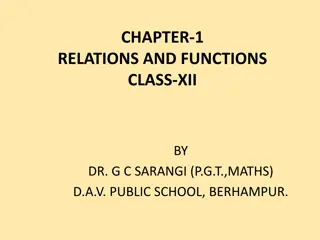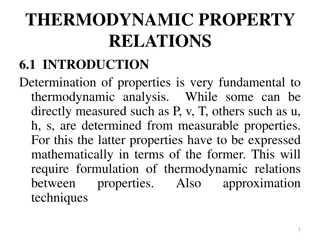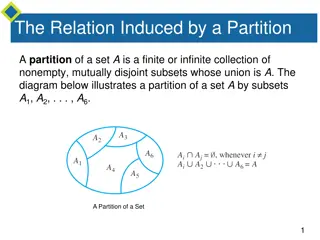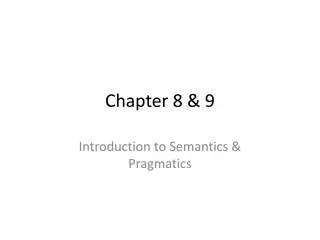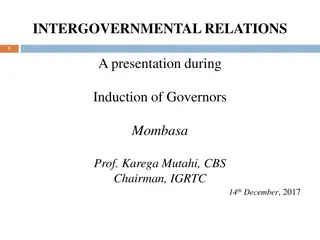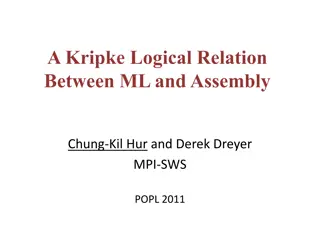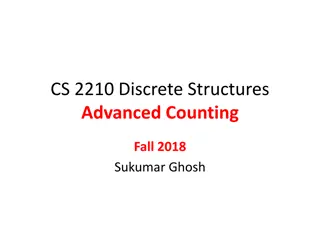Recurrence Relations and Solution Methods
Learn about solving recurrence relations, including the Master Theorem and Substitution Method. Dive into examples and techniques for efficient problem-solving. Follow step-by-step approaches for finding solutions and understanding the underlying concepts.
Download Presentation

Please find below an Image/Link to download the presentation.
The content on the website is provided AS IS for your information and personal use only. It may not be sold, licensed, or shared on other websites without obtaining consent from the author.If you encounter any issues during the download, it is possible that the publisher has removed the file from their server.
You are allowed to download the files provided on this website for personal or commercial use, subject to the condition that they are used lawfully. All files are the property of their respective owners.
The content on the website is provided AS IS for your information and personal use only. It may not be sold, licensed, or shared on other websites without obtaining consent from the author.
E N D
Presentation Transcript
Lecture 4 Median and Selection
Ed Heroes Bonus points for Ed participation!
Last Time: Solving Recurrence Relations A recurrence relation expresses ?(?) in terms of ?(less than ?) ? 2 For example, ? ? = 2 ? + 11 ? Two methods of solution: 1. Master theorem (aka, generalized tree method ) 2. Substitution method (aka, guess and check)
The Master Theorem Suppose ? 1,? > 1,and ?are constants (that don t depend on n). ? ? + ? ??. Then Suppose ? ? = ? ? Three parameters: a : number of subproblems b : factor by which input size shrinks d : need to do nd work to create all the subproblems and combine their solutions. A powerful theorem it is Jedi master Yoda
The Substitution Method Step 1: Guess what the answer is. Step 2: Prove by induction that your guess is correct. Step 3: Profit.
The plan for today 1. More practice with the Substitution Method. 2. k-SELECT problem 3. k-SELECT solution 4. Return of the Substitution Method.
A fun recurrence relation ? 5 7? 10 ? ? ? + ? + ? for ? > 10. Base case: ? ? = 1 when 1 ? 10 Apply here, the Master Theorem does NOT. Jedi master Yoda
The Substitution Method Step 1: Guess what the answer is. Step 2: Prove by induction that your guess is correct. Step 3: Profit.
Step 1: guess the answer ? 5 7? 10 ? ? ? + ? + ? for ? > 10. Base case: ? ? = 1 when 1 ? 10 Trying to work backwards gets gross fast We can also just try it out. (see Python notebook) Let s guess ?(?) and try to prove it.
Aside: Warning! It may be tempting to try to prove this with the inductive hypothesis ?(?) = ?(?) But that doesn t make sense! Formally, that s the same as saying: Inductive Hypothesis for n: There is some ?0> 0 and some ? > 0 so that, for all ? ?0, ? ? ? ?. The IH is supposed to hold for a specific n. But now we are letting n be anything big enough! Instead, we should pick ?first
Step 2: prove our guess is right We don t know what C should be yet! Let s go through the proof leaving it as C and then figure out what works ? 5 7? 10 ? ? ? + ? + ? for ? > 10. Base case: ? ? = 1 when 1 ? 10 Inductive Hypothesis: ? ? ?? Base case: 1 = ? ? ??for all 1 n 10 Inductive step: Let k > 10. Assume that the IH holds for all n so that 1 ? < ?. ? ? ? + ? 5+ ? ? + ? 5+ ? = ? +? 10? ?? ?? (aka, want to show that IH holds for n=k). Conclusion: There is some ? so that for all ? 1,? ? ?? By the definition of big-Oh, T(n) = O(n). ? 7? 10 Whatever we choose C to be, it should have C 1 ? 7? 10 5? +7? Let s solve for C and make this true! C = 10 works. (write out)
? 5 7? 10 ? ? ? + ? + ? for ? > 10. Step 3: Profit (Aka, pretend we knew this all along). Base case: ? ? = 1 when 1 ? 10 Theorem: ? ? = ? ? Proof: Inductive Hypothesis: ? ? ???. Base case: 1 = ?(?) ???for all 1 n 10 Inductive step: Let k > 10. Assume that the IH holds for all n so that 1 ? < ?. ? ? ? + ? 5+ ? ? + ?? 5+ ?? = ? + 2? + 7?= ??? Thus, IH holds for n=k. Conclusion: For all ? 1,? ? ??? Then, T(n) = O(n), using the definition of big-Oh with ?0= 1,? = 10. ? 7? 10 ? 7? 10
What have we learned? The substitution method can work when the master theorem doesn t. For example, with different-sized sub-problems. Step 1: generate a guess Throw the kitchen sink at it. Step 2: try to prove that your guess is correct You may have to leave some constants unspecified till the end then see what they need to be for the proof to work!! Step 3: profit Pretend you didn t do Steps 1 and 2 and write down a nice proof.
The Plan 1. More practice with the Substitution Method. 2. k-SELECT problem 3. k-SELECT solution 4. Return of the Substitution Method.
For today, assume all arrays have distinct elements. The k-SELECT problem from your pre-lecture exercise A is an array of size n, k is in {1, ,n} SELECT(A, k): Return the k-th smallest element of A. 7 4 3 8 1 5 9 14 Being sloppy about floors and ceilings! SELECT(A, 1) = 1 SELECT(A, 2) = 3 SELECT(A, 3) = 4 SELECT(A, 8) = 14 SELECT(A, 1) = MIN(A) SELECT(A, n/2) = MEDIAN(A) SELECT(A, n) = MAX(A) Note that the definition of Select is 1-indexed
On your pre-lecture exercise An O(nlog(n))-time algorithm SELECT(A, k): A = MergeSort(A) return A[k-1] It s k-1 and not k since my pseudocode is 0-indexed and the problem is 1-indexed Running time is O(n log(n)). So that s the benchmark . Show that you can t do better than O(n). Can we do better? We re hoping to get O(n)
Goal: An O(n)-time algorithm On your pre-lecture exercise: SELECT(A, 1). (aka, MIN(A)) MIN(A): ret = For i=0, ..., n-1: If A[i] < ret: ret = A[i] Return ret This loop runs O(n) times This stuff is O(1) Time O(n). Yay!
Also on your pre-lecture exercise How about SELECT(A,2)? (The actual algorithm here is not very important because this won t end up being a very good idea ) SELECT2(A): ret = minSoFar = For i=0, .., n-1: If A[i] < ret and A[i] < minSoFar: ret = minSoFar minSoFar = A[i] Else if A[i] < ret and A[i] >= minSoFar: ret = A[i] Return ret Still O(n) SO FAR SO GOOD.
SELECT(A, n/2) aka MEDIAN(A)? MEDIAN(A): ret = minSoFar = secondMinSoFar = thirdMinSoFar = fourthMinSoFar = . This is not a good idea for large k (like n/2 or n). Basically, this is just going to turn into something like INSERTIONSORT and that was O(n2).
The Plan 1. More practice with the Substitution Method. 2. k-SELECT problem 3. k-SELECT solution 4. Return of the Substitution Method.
Idea: divide and conquer! Say we want to find SELECT(A, k) 9 9 8 8 3 3 6 6 1 1 4 4 2 2 How about this pivot? First, pick a pivot. We ll see how to do this later. This PARTITION step takes time O(n). (Notice that we don t sort each half). Next, partition the array into bigger than 6 or less than 6 R = array with things larger than A[pivot] L = array with things smaller than A[pivot]
Idea: divide and conquer! Say we want to find SELECT(A, k) 6 6 How about this pivot? First, pick a pivot. We ll see how to do this later. This PARTITION step takes time O(n). (Notice that we don t sort each half). Next, partition the array into bigger than 6 or less than 6 9 8 3 1 4 2 R = array with things larger than A[pivot] L = array with things smaller than A[pivot]
Idea continued Say we want to find SELECT(A, k) 6 pivot 4 2 3 1 9 8 L = array with things smaller than A[pivot] R = array with things larger than A[pivot] If k = 5 = len(L) + 1: We should return A[pivot] If k < 5: We should return SELECT(L, k) If k > 5: We should return SELECT(R, k 5) This suggests a recursive algorithm (still need to figure out how to pick the pivot )
getPivot(A)returns some pivot for us. How?? We ll see later Partition(A,p) splits up A into L, A[p], R. See Lecture 4 Python notebook for code Pseudocode Select(A,k): If len(A) <= 50: A = MergeSort(A) Return A[k-1] p = getPivot(A) L, pivotVal, R = Partition(A,p) if len(L) == k-1: return pivotVal Else if len(L) > k-1: return Select(L, k) Else if len(L) < k-1: return Select(R, k len(L) 1) Base Case: If len(A) = O(1), then any sorting algorithm runs in time O(1). Case 1: We got lucky and found exactly the k th smallest value! Case 2: The k th smallest value is in the first part of the list Case 3: The k th smallest value is in the second part of the list
Convince yourself that Select is correct! Does it work? Check out the Python notebook for Lecture 4, which implements this with a bunch of different pivot-selection methods. Seems to work! Check out the lecture notes for a rigorous proof based on induction that this works, with any pivot- choosing mechanism. It provably works! Also, this is a good example of proving that a recursive algorithm is correct.
What is the running time? Assuming we pick the pivot in time O(n) ? ??? ? + ? ? ??? ? > ? 1 ? ? = ? ??? ? ? ? + ? ? ??? ? < ? 1 ??? ? = ? 1 What are len(L) and len(R)? That depends on how we pick the pivot What would be a good pivot? What would be a bad pivot? Think: one minute Share: (wait) one minute The best way would be to always pick the pivot so that len(L) = k-1. But say we don t have control over k, just over how we pick the pivot. Think-Share Terrapins
The ideal pivot We split the input exactly in half: len(L) = len(R) = (n-1)/2 What happens in that case? Think: one minute Share: (wait) one minute In case it s helpful ? ?+ ? ??. Then Suppose ? ? = ? ? O ??log ? O ?? O ?log?? if ? = ?? if ? < ?? if ? > ?? ? ? =
The ideal pivot Apply here, the Master Theorem does NOT. Making unsubstantiated assumptions about problem sizes, we are. We split the input exactly in half: len(L) = len(R) = (n-1)/2 Let s pretend that s the case and use the Master Theorem! ? 2 ? ? ? + ?(?) Jedi master Yoda So a = 1, b = 2, d = 1 ? ?+ ? ??. Then Suppose ? ? = ? ? ? ? ? ??= ? ? O ??log ? O ?? O ?log?? if ? = ?? if ? < ?? if ? > ?? ? ? = That would be great!
The worst pivot Say our choice of pivot doesn t depend on A. A bad guy who knows what pivots we will choose gets to come up with A. 2 1 3 pivot
The distinction matters! For this one I chose the worst possible pivot. Looks like O(n2). This one is a random pivot, so it splits the array about in half. Looks fast! See Lecture 4 Python notebook for code that generated this picture.
How do we pick a good pivot? Randomly? That works well if there s no bad guy. But if there is a bad guy who gets to see our pivot choices, that s just as bad as the worst-case pivot. Aside: In practice, there is often no bad guy. In that case, just pick a random pivot and it works really well! (More on this next lecture)
How do we pick a good pivot? For today, let s assume there s this bad guy. Reasons: This gives us a very strong guarantee We ll get to see a really clever algorithm. Necessarily it will look at A to pick the pivot. We ll get to use the substitution method.
The Plan 1. More practice with the Substitution Method. 2. k-SELECT problem 3. k-SELECT solution a) The outline of the algorithm. b) How to pick the pivot. 4. Return of the Substitution Method.
Approach First, we ll figure out what the ideal pivot would be. But we won t be able to get it. Then, we ll figure out what a pretty good pivot would be. But we still won t know how to get it. Finally, we will see how to get our pretty good pivot! And then we will celebrate.
How do we pick our ideal pivot? We d like to live in the ideal world. Pick the pivot to divide the input in half. Aka, pick the median! Aka, pick SELECT(A, n/2)!
How about a good enough pivot? We d like to approximate the ideal world. Pick the pivot to divide the input about in half! Maybe this is easier!
We still dont know that we can get such a pivot, but at least it gives us a goal and a direction to pursue! A good enough pivot We split the input not quite in half: 3n/10 < len(L) < 7n/10 3n/10 < len(R) < 7n/10 Lucky the lackadaisical lemur If we could do that (let s say, in time O(n)), the Master Theorem would say: 7? 10 ? ? ? + ?(?) ? ?+ ? ??. Then Suppose ? ? = ? ? So a = 1, b = 10/7, d = 1 ? ? ? ??= ? ? STILL GOOD!
Goal Efficiently pick the pivot so that 6 pivot 4 2 3 1 9 8 L = array with things smaller than A[pivot] R = array with things larger than A[pivot] ?? ?? < ??? ? <?? ?? ?? < ??? ? <?? ?? ??
Another divide-and-conquer alg! We can t solve SELECT(A,n/2)(yet) But we can divide and conquer and solve SELECT(B,m/2) for smaller values of m (where len(B) = m). Lemma*: The median of sub-medians is close to the median. Ideal pivot What we ll use as the pivot median of the whole thing median of sub-medians sub-median sub-median sub-median sub-median sub-median *we will make this a bit more precise.
How to pick the pivot CHOOSEPIVOT(A): Split A into m = For i=1, .., m: Find the median within the i th group, call it pi p = SELECT( [ p1, p2, p3, , pm ] , m/2 ) return the index of p in A ? 5 groups, of size <=5 each. Why 5 and not 3? See the concept check questions! This takes time O(1) for each group, since each group has size 5. So that s O(m)=O(n) total in the for loop. 8 4 12 2 1 5 5 20 1 8 9 3 15 5 9 1 3 4 15 13 2 4 6 12 1 15 22 3 6 Pivot is SELECT( , 3 ) = 6: 8 4 5 6 12 12 6 5 12 2 1 20 1 8 9 3 15 5 9 1 3 4 15 13 2 4 12 1 15 22 3 PARTITION around that 6: 6 5 15 12 15 22 8 9 15 9 12 20 13 1 3 1 3 4 2 1 2 4 1 3 5 This part is L This part is R: it s almost the same size as L.
CLAIM: this works divides the array approximately approximately in half Empirically (see Lecture 4 Python Notebook):
CLAIM: this works divides the array approximately approximately in half Formally, we will prove (later): Lemma: If we choose the pivots like this, then ? 7? 10+ 5 and ? 7? 10+ 5
Sanity Check ? 7? 10+ 5 and ? 7? 10+ 5 In practice (on randomly chosen arrays) it looks even better! But this is a worst-case bound. That s this window
How about the running time? Suppose the Lemma is true. (It is). ? 7? 10+ 5 and ? 7? 10+ 5 Recurrence relation: ? ? ? Think: 1 minute Share: (wait) 1 minute
Lemma says that ? 7? 10+ 5 and ? 7? 10+ 5 Suppose Partition runs in time O(n) Come up with a recurrence relation for T(n), the running time of Select, using the choosePivot algorithm we just described. Pseudocode Select(A,k): If len(A) <= 50: A = MergeSort(A) Return A[k-1] p = choosePivot(A) L, pivotVal, R = Partition(A,p) if len(L) == k-1: return pivotVal Else if len(L) > k-1: return Select(L, k) Else if len(L) < k-1: return Select(R, k len(L) 1) Base Case: If len(A) = O(1), then any sorting algorithm runs in time O(1). Case 1: We got lucky and found exactly the k th smallest value! Case 2: The k th smallest value is in the first part of the list Case 3: The k th smallest value is in the second part of the list
How about the running time? Suppose the Lemma is true. (It is). ? 7? 10+ 5 and ? 7? 10+ 5 Recurrence relation: ? 5 7? 10 ? ? ? + ? + ? ? The call to CHOOSEPIVOT makes one further recursive call to SELECT on an array of size n/5. Outside of CHOOSEPIVOT, there s at most one recursive call to SELECT on array of size 7n/10 + 5. We re going to drop the +5 for convenience, but it does not change the final answer. Why? Hint: Define T (n) := T(n+1000) and write recurrence for T Siggi the Studious Stork
The Plan 1. More practice with the Substitution Method. 2. k-SELECT problem 3. k-SELECT solution a) The outline of the algorithm. b) How to pick the pivot. 4. Return of the Substitution Method.
This sounds like a job for Step 1: generate a guess Step 2: try to prove that your guess is correct Step 3: profit ? 5 7? 10 ? ? ? + ? + ?(?) That s convenient! We did this at the beginning of lecture! Technically we only did it for ? ? ? 5 + ? not when the last term has a big-Oh ? 7? 10 + ?, Conclusion: ? ? = ? ? Plucky the Pedantic Penguin
Recap of approach First, we figured out what the ideal pivot would be. Find the median Then, we figured out what a pretty good pivot would be. An approximate median Finally, we saw how to get our pretty good pivot! Median of medians and divide and conquer! Hooray!







